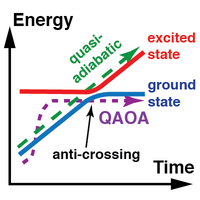当前位置:
X-MOL 学术
›
Phys. Rev. X
›
论文详情
Our official English website, www.x-mol.net, welcomes your
feedback! (Note: you will need to create a separate account there.)
Quantum Approximate Optimization Algorithm: Performance, Mechanism, and Implementation on Near-Term Devices
Physical Review X ( IF 11.6 ) Pub Date : 2020-06-24 , DOI: 10.1103/physrevx.10.021067 Leo Zhou , Sheng-Tao Wang , Soonwon Choi , Hannes Pichler , Mikhail D. Lukin
Physical Review X ( IF 11.6 ) Pub Date : 2020-06-24 , DOI: 10.1103/physrevx.10.021067 Leo Zhou , Sheng-Tao Wang , Soonwon Choi , Hannes Pichler , Mikhail D. Lukin

|
The quantum approximate optimization algorithm (QAOA) is a hybrid quantum-classical variational algorithm designed to tackle combinatorial optimization problems. Despite its promise for near-term quantum applications, not much is currently understood about the QAOA’s performance beyond its lowest-depth variant. An essential but missing ingredient for understanding and deploying the QAOA is a constructive approach to carry out the outer-loop classical optimization. We provide an in-depth study of the performance of the QAOA on MaxCut problems by developing an efficient parameter-optimization procedure and revealing its ability to exploit nonadiabatic operations. Building on observed patterns in optimal parameters, we propose heuristic strategies for initializing optimizations to find quasioptimal -level QAOA parameters in time, whereas the standard strategy of random initialization requires optimization runs to achieve similar performance. We then benchmark the QAOA and compare it with quantum annealing, especially on difficult instances where adiabatic quantum annealing fails due to small spectral gaps. The comparison reveals that the QAOA can learn via optimization to utilize nonadiabatic mechanisms to circumvent the challenges associated with vanishing spectral gaps. Finally, we provide a realistic resource analysis on the experimental implementation of the QAOA. When quantum fluctuations in measurements are accounted for, we illustrate that optimization is important only for problem sizes beyond numerical simulations but accessible on near-term devices. We propose a feasible implementation of large MaxCut problems with a few hundred vertices in a system of 2D neutral atoms, reaching the regime to challenge the best classical algorithms.
中文翻译:

量子近似优化算法:近期设备的性能,机制和实现
量子近似优化算法(QAOA)是一种旨在解决组合优化问题的混合量子经典变异算法。尽管它承诺在近期的量子应用中使用,但是对于QAOA的性能,除了其最低深度的变种以外,目前还知之甚少。对于理解和部署QAOA而言,必不可少的要素是进行外循环经典优化的建设性方法。通过开发有效的参数优化程序并揭示其利用非绝热操作的能力,我们对QAOA在MaxCut问题上的性能进行了深入研究。基于最佳参数中观察到的模式,我们提出启发式策略以初始化优化以找到准最优级别的QAOA参数 时间,而随机初始化的标准策略则需要 优化运行以获得类似的性能。然后,我们对QAOA进行基准测试,并将其与量子退火进行比较,尤其是在困难的情况下,由于较小的光谱间隙,绝热量子退火会失败。比较表明,QAOA可以通过优化来学习,以利用非绝热机制来规避与消失的谱带有关的挑战。最后,我们提供了有关QAOA实验实施的现实资源分析。当考虑到测量中的量子波动时,我们说明优化仅对于超出数值模拟但可在短期设备上访问的问题大小很重要。我们提出了在二维中性原子系统中具有几百个顶点的大型MaxCut问题的可行实施方案,
更新日期:2020-06-24
中文翻译:

量子近似优化算法:近期设备的性能,机制和实现
量子近似优化算法(QAOA)是一种旨在解决组合优化问题的混合量子经典变异算法。尽管它承诺在近期的量子应用中使用,但是对于QAOA的性能,除了其最低深度的变种以外,目前还知之甚少。对于理解和部署QAOA而言,必不可少的要素是进行外循环经典优化的建设性方法。通过开发有效的参数优化程序并揭示其利用非绝热操作的能力,我们对QAOA在MaxCut问题上的性能进行了深入研究。基于最佳参数中观察到的模式,我们提出启发式策略以初始化优化以找到准最优级别的QAOA参数 时间,而随机初始化的标准策略则需要 优化运行以获得类似的性能。然后,我们对QAOA进行基准测试,并将其与量子退火进行比较,尤其是在困难的情况下,由于较小的光谱间隙,绝热量子退火会失败。比较表明,QAOA可以通过优化来学习,以利用非绝热机制来规避与消失的谱带有关的挑战。最后,我们提供了有关QAOA实验实施的现实资源分析。当考虑到测量中的量子波动时,我们说明优化仅对于超出数值模拟但可在短期设备上访问的问题大小很重要。我们提出了在二维中性原子系统中具有几百个顶点的大型MaxCut问题的可行实施方案,











































 京公网安备 11010802027423号
京公网安备 11010802027423号